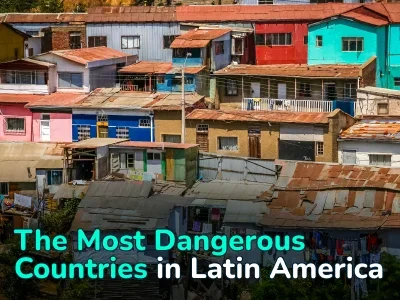
Where Not to Buy Real Estate: Top Countries with Overbooked and Illiquid Markets
When people think about buying property, they tend to focus on popular destinations without taking a close look at the local market, which is a serious oversight.
Markets differ not only from country to country but also from city to city within the same country. Overheated markets are prone to sharp price corrections, while places with more attractive prices may have properties that remain illiquid for years.
This environment makes the traditional approach of “buying property in a good city with guaranteed growth” unreliable. In several major cities, the price per square meter has already drifted away from real purchasing power, and returns for investors can be lower than regular bank deposits.
We prepared a review of the worst cities for buying real estate. Since this concept is complex by nature, we created three independent rankings. Each one highlights not just “bad” locations but specific types of risk an investor may face.
Top 5 Cities in the World with Overheated Real Estate Markets
Before moving to the cities themselves, it is important to clarify two key indicators used to determine how overheated a market is: price-to-income and price-to-rent. These are universal metrics applied by banks and international research institutes to assess whether housing prices align with real economic conditions.
Price-to-income (housing affordability ratio) reflects the median property price relative to a household’s annual income. Although called a ratio, in practice it shows how many years of income are needed to purchase a home.
Examples:
- 3–5× means a home costs three to five annual household incomes.
- 7–9× means seven to nine annual incomes.
- 10–15× means ten to fifteen annual incomes.
When the price exceeds the annual income by a factor of ten to fifteen, it signals that local demand can no longer sustain the market. Further growth relies on speculative and external demand, which is a classic indicator of overheating.
Price-to-rent (payback period) shows how many years of rent would be required to cover the purchase price.
Examples:
- 10–15 years is normal for developed economies.
- 15–20 years indicates overvaluation.
If the payback period exceeds twenty to twenty-five years, rental yields fall below alternative investment options. In this case, the buyer is essentially paying for the expectation of future price growth rather than for current cash flow.
Hong Kong
Hong Kong remains the benchmark of an overheated market. The housing affordability ratio stays in the fourteen to seventeen range, a level international rankings classify as severely unaffordable. Even after a price correction of roughly twenty-five percent from the 2022 peak, the average price per square meter still exceeds $18 to $23 thousand. This payback period is comparable to the return on a bank deposit but involves significantly higher risk.
Sydney
In 2025, Sydney reached the top position globally in housing unaffordability after the median property price rose to fourteen to fifteen times the annual household income. The average home price across the metropolitan area is approaching seven hundred eighty thousand dollars, which effectively moves it beyond the reach of the middle class. Rental yields remain low at about 2.5 to 3 percent for houses and slightly above 3 percent for apartments. Demand is driven not by economic fundamentals but by a catch-up market mindset and expectations of continuous growth. Any tightening of lending conditions or slowdown in migration would put pressure on prices.
Toronto
Over the past decade, Toronto has shifted from a stable market to a high-risk one. The affordability ratio is now around nine to eleven, and the price-to-rent metric in central districts exceeds twenty-four years. The average home price in the metropolitan area is about seven hundred ninety thousand dollars. Rental yields usually do not rise above 4 percent and tend to stay near 3 to 3.5 percent. The market has already undergone a noticeable correction after rate hikes, yet prices remain fundamentally overvalued. A high share of investor-driven purchases makes the market highly sensitive to changes in financial conditions.
Munich
Munich is considered one of the most expensive real estate markets in Europe. The average home price equals twelve to thirteen annual household incomes, and the price per square meter consistently remains in the eight and a half to nine thousand euro range. Rental yields are low and rarely exceed 3 percent. With these parameters, the payback period approaches thirty to thirty-three years, which effectively removes the segment from the category of viable investments.
Miami
The average home price in Miami is lower than in the other cities on this list, at about five hundred seventy to six hundred thousand dollars. Considering the 3 percent price decline in 2024–2025, this does not look alarming. Even so, the market remains clearly overvalued. The estimated payback period is fifteen to sixteen years, which is above the national average. The most critical issue is the rapid rise in insurance costs. In coastal zones, they have been increasing at double-digit rates despite a drop in the overall number of claims. At this point, the Miami market has become one of the most vulnerable in North America.
Top 5 Cities in the World with the Lowest Rental Yields
Low rental yields show how well a property can generate cash flow. Price to rent reflects the payback period, while actual yield shows the efficiency of the asset as an investment. In developed markets, a gross yield of 5 to 7 percent is considered normal, and net yield usually stands at about 3 to 5 percent after maintenance, utilities, taxes, repairs, and management fees. When yields fall to 2 to 3 percent or lower, residential property becomes a way to store capital rather than grow it.
Paris
Paris is one of the clearest examples of a city where the price per square meter has moved far beyond what the rental market can support. In the central districts, the average gross yield ranges from 2.5 to 3 percent, and net yield sometimes fails to reach even 2 percent, which is comparable to a standard bank deposit.
London
London attracts global capital, but for investors relying on rental income, the city offers little advantage. In popular districts, yields rarely exceed 2.8 to 3.3 percent, and in central areas, they fall to about 2 to 2.5 percent, combined with very high ownership costs.
Singapore
Singapore shows some of the lowest rental yields in Asia. Even after periods of rising demand, the average yield across many residential categories stays at 2.5 to 3.5 percent. This is very low for a highly urbanized market. Maintenance, repairs, and management fees reduce the net income even further.
Shanghai
Shanghai is the weakest performer in Asia. Rental yields remain consistently low at about 2 to 3 percent. This is a result of strict government policies in the housing sector. High property prices, limited availability for foreign buyers, and regulated rental rates make the market suited for residence rather than investment.
Tokyo
Tokyo combines relatively affordable rents for residents with high purchase costs for foreign investors. The average yield on residential properties stays near 3 to 4 percent. A large portion of buildings face physical wear and functional aging, which increases maintenance expenses and reduces the net yield.
Top 5 Cities in the World with the Lowest Real Estate Liquidity
Low liquidity is often underestimated when buying property, and this is a serious mistake. Low rental yields indicate weak cash flow, and an overheated market suggests a risk of price decline. Low liquidity means it will be difficult to sell the asset. A property can remain on the market for months or even years, and a real buyer appears only after a significant price reduction.
Cairo
Cairo is the capital of Egypt and the largest metropolis in North Africa. The gap between supply and the population’s purchasing power is enormous. As a result, the average listing period in new districts often exceeds six to twelve months, and transactions close at prices fifteen to twenty percent below initial asking levels. Fragmentation of the market makes the situation worse because many development projects are launched without guaranteed demand.
Antalya
Antalya has experienced explosive construction growth in recent years, far ahead of real demand. Periods when residence permits were restricted for property buyers weakened foreign interest and led to listing periods of five to eight months or longer. Against the backdrop of a volatile national currency and extremely high inflation, negotiations are tough, and discounts of ten to fifteen percent are common.
Dubai
Dubai frequently appears in the news as a fast-growing city with many new projects. However, large-scale construction gradually reduces liquidity in the secondary market. In some complexes, the volume of new supply is so high that resale properties move slowly and with a significant discount. In certain segments, the listing period reaches one hundred twenty to one hundred fifty days, especially in areas where dozens of buildings are released at the same time.
Athens
Housing in Athens was in strong demand because it allowed buyers to qualify for Greece’s golden visa. After the rules were tightened, demand decreased, and the market faced a sharp drop in liquidity. Listing periods for secondary housing in some districts exceed one hundred sixty to one hundred eighty days. In areas oriented toward foreign buyers, the figure approaches one year.
Johannesburg
Johannesburg is one of the least liquid major markets in Africa. There are small enclaves with stable demand, but most of the market suffers from low purchasing power and high crime levels. Listings can receive no serious interest for more than a year, even when sellers offer discounts of twenty percent or more.
To Sum Up
A city that is a poor choice for buying real estate is not defined by a single market condition. It reflects at least three different types of risk. When a market is overheated, as shown by price to income and price to rent, the likelihood of a price correction increases after any shock, from higher interest rates to slower economic growth.
Low rental yields, which signal weak cash flow, directly affect how long it will take for a property to pay for itself and when an investor will start earning real profit. This is closely linked to liquidity because illiquid properties often sit on the market and generate losses during vacancies.
In practical terms, these locations should not be dismissed entirely. They remain suitable either for very wealthy buyers who intentionally lock up capital for a long period or for those solving a personal need, such as living in a specific city, regardless of cost. For everyone else, the combination of overheating, weak rental performance, and poor liquidity makes these cities some of the worst choices for property investment, especially when the goal is profit.
Author
I write informative articles about real estate, investments, job opportunities, taxes, etc.



















